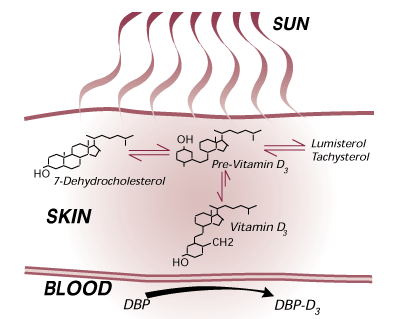Vitamins, Hormones, and Bones: Have You Had Your Vitamins Today?
The importance of estrogen for maintaining bone mineral density has been known and appreciated for women many years. However, estrogen is not the only hormone that is important to maintaining strong bones. One of the most important hormones for maintaining strong bones, Vitamin D, usually isn’t thought of as a hormone. While the consequences of Vitamin D deficiency have been recognized for centuries, the structure of Vitamin D and its role as a hormone was not determined until the 1930’s.
We obtain Vitamin D naturally through two different routes.
Natural dietary sources of vitamin D are rare. Fatty fish such as salmon and mackerel, as well as cod liver oil (1 T = 35 IU) provide some vitamin D. It would be very difficult to meet the RDA for vitamin D from naturally occurring dietary sources. As a consequence, many cereal and dairy products are fortified with vitamin D, and represent the major dietary source for most individuals.
 |
The majority of our vitamin D requirements are met through the UV dependent conversion of 7-dehydocholesterol to vitamin D in the skin. Vitamin D is then converted to 25 OH Vitamin D in the liver. The 25 OH Vitamin D is the major circulating form of vitamin D, and is the best indicator of vitamin D sufficiency. The major active form of vitamin D is formed in the kidney where 25 OH vitamin D is converted to 1, 25 (OH)2 vitamin D. Due to its effects on calcium homeostasis, the formation of 1,25 (OH)2 vitamin D is tightly controlled by the body.
The active form of vitamin D has effects on three major target tissues; bone, intestine, and kidney.
In the kidney, vitamin D promotes calcium reabsoption in the proximal tubules. In bone, the effects of vitamin D can be either to promote bone resorption or formation, depending on the calcium balance in the subject. In the intestine, vitamin D upregulates the expression of calcium receptors, enhancing the absorption of calcium. In the absence of vitamin D, dietary calcium is not efficiently absorbed.
Sufficient blood concentrations of vitamin D are essential to maintaining a proper Ca++ balance that does not compromise bone mass.
As we age, the concentration of Ca++ receptors in the intestinal tract decreases, making it more important that the remaining receptors are working efficiently. Evaluation of a normal adult diet in the United States suggests a dietary intake of less than 100 IU/day of vitamin D. This is below the RDA of 200 IU/day, and far below the 400 IU to 800 IU/day utilized in studies of vitamin D and calcium for the prevention of bone loss in individuals at risk for osteoporosis.
 |  |
| Recommended Daily Allowances | ||
| AGE GROUPS | CALCIUM | VITAMIN D |
| Children: 0 – 1 year 1 – 3 years 4 – 8 years 9 – 18 years | 250 mg 500 mg 800 mg 1300 mg | 300 IU 300 IU 400 IU 400 IU |
| Adults | 1000 mg | 200 IU |
| Pregnant/Lactating Women | 1200 mg | 400 IU |
Because of poor dietary intake, the majority of vitamin D is obtained through exposure to sunlight.
Age, race, time of day, season of the year, latitude of location, and use of sunscreens can dramatically influence the production of vitamin D in the skin. Individuals in Boston produce little or no vitamin D in the winter months from November to February. A sunscreen of SPF 8 can reduce the efficiency of vitamin D production by 95%. During the winter months, vitamin D produced in the summer months will be released from fat reservoirs. However, frequently the elderly or the homebound have insufficient stores to maintain calcium homeostasis. Under these conditions, the body mobilizes Ca++ from the only other available storage reservoir, bone, leading to a net loss of bone mass.
As we can see, vitamin D plays an essential role in the maintenance of a proper calcium balance in the body.
 | |
A proper calcium balance is essential to maintaining adequate bone mass. Studies have suggested that supplementation with calcium and vitamin D may be nearly as effective as estrogen replacement therapy or bisphosphonate therapy in preventing bone loss in the elderly. Controlled clinical trials for both hormone replacement and bisphosphonate therapies have included supplementation of calcium and vitamin D where necessary. Adequate vitamin D and calcium levels are essential to the success of either of these treatment modalities. Some investigators have suggested that the difference between the success rates of controlled clinical trials and general patient populations may reflect the extent to which the general patient population is vitamin D deficient.
Vitamin D insufficiency may be difficult to detect without specific laboratory testing.
Gross deficiencies in vitamin D lead to recognizable conditions such as rickets. Because of vitamin D fortification in many foods, gross deficiencies are not often reported in the US. Minor insufficiencies may go unnoticed entirely. Greater insufficiencies may be masked as secondary hyperparathyroidism, as the body attempts to maintain its calcium balance at the expense of bone mass. Given the importance of sufficient vitamin D concentrations in individuals at risk for bone loss, it is tempting to merely supplement everyone.
Lastly, vitamin D in excessive amounts is toxic. In addition, there is little correlation between vitamin D dosage and vitamin D blood levels. Adequate supplementation in one individual may not be adequate in another. Therefore, supplementation regimens need to be tailored to the individual.

